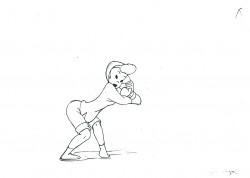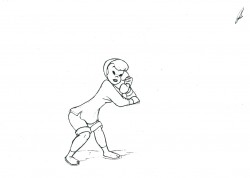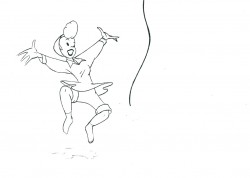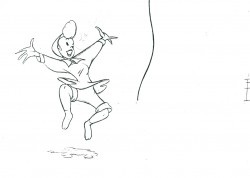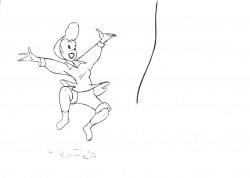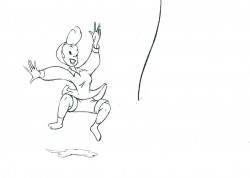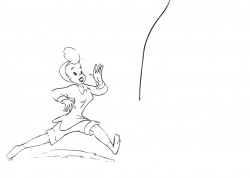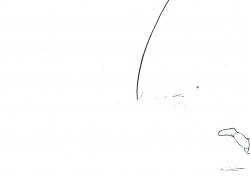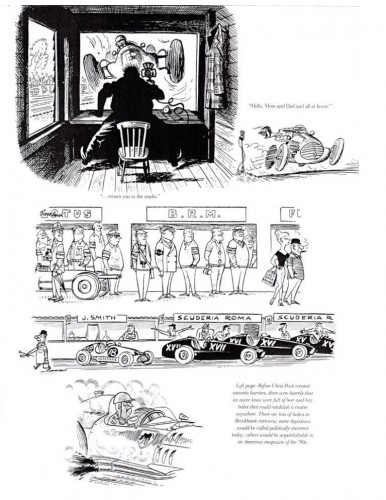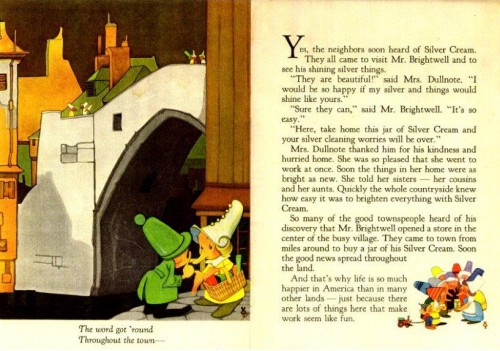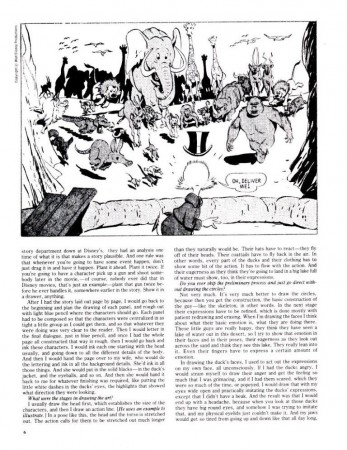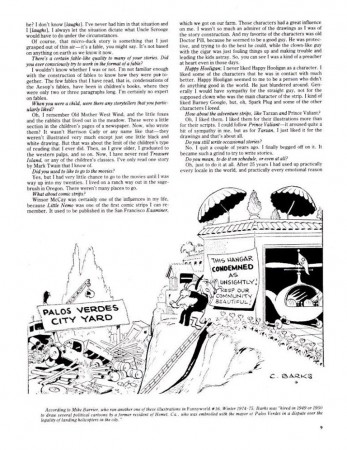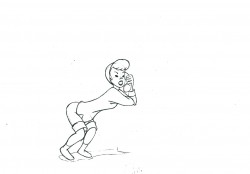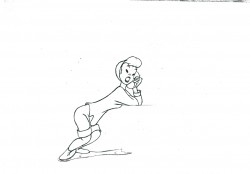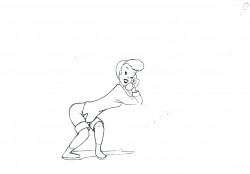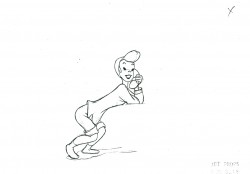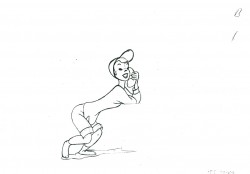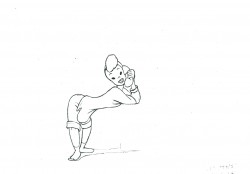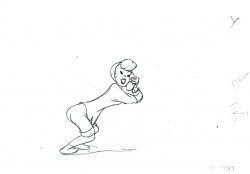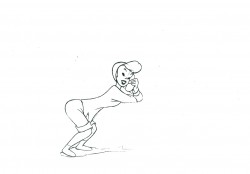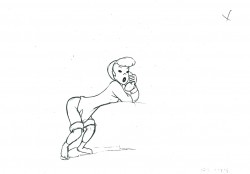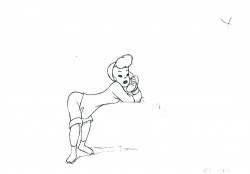Monthly ArchiveMay 2010
Animation &Animation Artifacts &Disney 11 May 2010 08:09 am
Dumbo’s Bath
Hans Perk has been posting the drafts for Dumbo, and this has led Mark Mayerson to start posting the brilliant Mosaics he creates for the film.
I want to join in celebrating this feature, which is one of my very favorite animated films , and I’ve decided – since I’ve already done a lot of behind the scenes posts – I’ll recap a number of those posts in the next week or so.
I start with this one of Dumbo’s bath animated by Bill Tytla and boarded by Bill Peet.
.
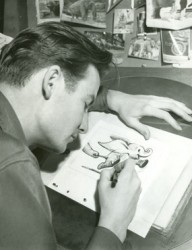 - Thanks to a loan from John Canemaker, I can continue posting some of the brilliant storyboard work of Bill Peet. The guy was a masterful artist. Every panel gives so much inspiration and information to the animators, directors and artists who’ll follow up on his work.
- Thanks to a loan from John Canemaker, I can continue posting some of the brilliant storyboard work of Bill Peet. The guy was a masterful artist. Every panel gives so much inspiration and information to the animators, directors and artists who’ll follow up on his work.
This is the sequence from Dumbo wherein baby Dumbo plays around the feet of his mother. Brilliantly animated by Bill Tytla, this sequence is one of the greatest ever animated. No rotoscoping, no MoCap. Just brilliant artists collaborating with perfect timing, perfect structure, perfect everything. Tytla said he watched his young son at home to learn how to animate Dumbo. Bill Peet told Mike Barrier that he was a big fan of circuses, so he was delighted to be working on this piece. Both used their excitement and enthusiasm to bring something brilliant to the screen, and it stands as a masterpiece of the medium.
Of this sequence and Tytla’s animation, Mike Barrier says in Hollywood Cartoons, “What might otherwise be mere cuteness acquires poignance because it is always shaded by a parent’s knowledge of pain and risk. If Dumbo “acted” more, he would almost certainly be a less successful character—’cuter,’ probably, in the cookie-cutter manner of so many other animated characters, but far more superficial.”
I had to take the one very long photstat and reconfigure it in photoshop so that you could enlarge these frames to see them well. I tried to keep the feel of these drawings pinned to that board in tact.
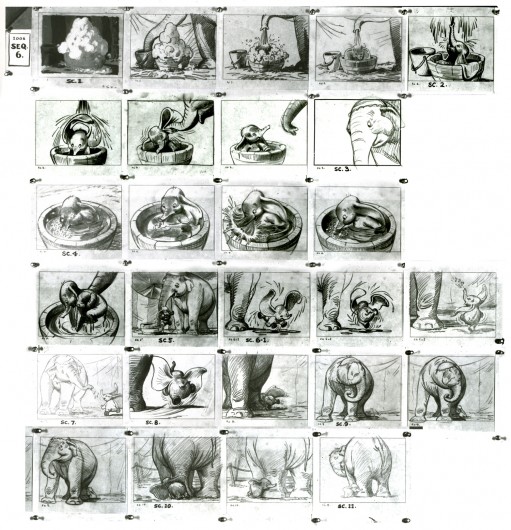
(Click any image to enlarge.)
Here are frame grabs from the very same sequence of the film showing how closely the cuts were followed. Even in stills the sequence is stunning.


(Click any image to enlarge.)
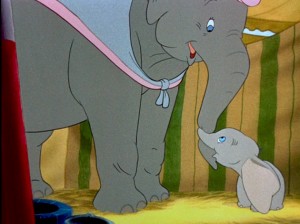 .
.This film is a gem.
The dvd also has one of my favorite commentary tracks throughout.
John Canemaker, by himself, talking about the film. It’s great!
From Hans Perk’s A Film LA:
Seq. 06.0 “Menagerie – Mrs. Jumbo Goes Berserk”
Directed by Wilfred Jackson, assistant director Jacques [Roberts?], layout Terrell Stapp.
Dumbo being washed by Mrs. Jumbo, animated by Bill Tytla, with effects by Art Palmer, Cornett Wood and Sandy Strother.
Animation &Animation Artifacts &Disney 10 May 2010 07:56 am
All the Cats – part 4
- This scene is a continuation of animation from All the Cats Join In from Make Mine Music. It’s another scene by Fred Moore and is, to me, one of the highlights of the film. The girl keeps jitterbugging even though she’s rapt in conversation on the phone.
The problem I had with this artwork was that the xerox copies offered no registration marks, and there were no visible numbers on most of the drawings. Consequently, I did the best I could to register them.
As in the past we start with the last drawing from the last post.
 41
41
The following QT movie represents all the drawings in the scene.
Since I had no numbers to go by, I exposed all drawings on twos.
Right side to watch single frame.
Articles on Animation &Puppet Animation 09 May 2010 08:10 am
Close Up Magazine
David Prestone published a magazine in the late 70′s called Closeup Magazine. This was a professionally produced magazine that featured articles on stop motion puppet animation and special effects. Sadly the magazine stopped production after the third issue.
I’d posted a number of pieces from the second issue of the magazine, which featured interviews from many of the animators who worked on the 50′s puppet film, Hansel and Gretel. see here and here.
David now tells me that he has a number of collector’s issues still in great condition and would like to sell them. To that end, I’m posting all the information he’s sent me about all three issues, and I strongly encourage you to buy them. They’re truly gems from the past about an often neglected subject – stop-motion animation.
 CLOSEUP ONE: Our premier issue, leads off with an exhaustive thirty five page filmbook treatment of “The Golden Voyage of Sinbad” including detailed examinations of the special effects, musical score,origins of the mythological creatures used, etc. A five page article on the making of “Flesh Gordon” follows (with complete plot synopsis), and a discussion of the first seventeen episodes of the “Land of the Lost” television series rounds out the magazine. In extremely short supply.
CLOSEUP ONE: Our premier issue, leads off with an exhaustive thirty five page filmbook treatment of “The Golden Voyage of Sinbad” including detailed examinations of the special effects, musical score,origins of the mythological creatures used, etc. A five page article on the making of “Flesh Gordon” follows (with complete plot synopsis), and a discussion of the first seventeen episodes of the “Land of the Lost” television series rounds out the magazine. In extremely short supply.
CLOSEUP TWO: All interview issue. Six stop-motion animators discuss the making of such filmlas “The Time Machine,” “The
Wonderful World of the Brothers Grimm,” “Dinosaurus,” “Tom Thumb,” “Alice in Wonderland” and many seldom seen animated
television commercials. Over 100 rare, behind-the-scenes photographs. Plus: Kathryn Grant, Kerwin Mathews, and scenes from Ray Harryhausen’s latest film, “Sinbad and the Eye of the Tiger.”
Here’s a flyer that David did for issue #3:
 THE KING KONG LETTERS — The genesis of “The Making of King Kong” by Orville Goldner and George Turner-traced through quotes from correspondence with author Turner. Including interviews and comments from: Marcel Delgado, Ernest Schoedsack and Ruth Rose, Orville Goldner, Merian C. Cooper and other members of the cast and crew of this film classic. Illustrated with rare advertisements and campaign material from the super-scarce Kong 1933 and ’38 pressbooks.
THE KING KONG LETTERS — The genesis of “The Making of King Kong” by Orville Goldner and George Turner-traced through quotes from correspondence with author Turner. Including interviews and comments from: Marcel Delgado, Ernest Schoedsack and Ruth Rose, Orville Goldner, Merian C. Cooper and other members of the cast and crew of this film classic. Illustrated with rare advertisements and campaign material from the super-scarce Kong 1933 and ’38 pressbooks.
KING KONG UNCENSORED – A look at Kong’s darker side . . . Kong the killer, storming through the native village indiscriminantly killing and maiming to regain his bride. Kong in Manhattan, chewing New Yorkers, dropping women out of windows, creating havoc and wanton destruction. All of the effects scenes that were shot and later deleted (and censored) from the film, fully described, with quotes from the original Kong shooting script and hard cover novelization. Illustrated with two never before published pre-production sketches by artist Mario Larrinaga, and some of the best fan art around.
KING KONG UNCHAINED – A retrospective look at the “Fight Heard ‘Round the World” . . . Kong’s stupendous battle in the grotto with the King of Dinosaurs: Tyrannosaurus Rex!
THE KING KONG YOU’LL NEVER SEE – The full story behind “The Legend of King Kong”: Universal Pictures’ stillborn Kong remake, which would have utilized the talents of stop-motion animator, JIM DANFORTH.
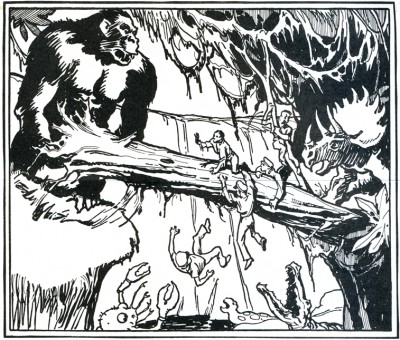
All King Kong artworkis by Glen Cravath
and was done in 1933 fpr inclusion in
the King Kong/RKO pressbook.
KING KONG DETHRONED – A talk with Rick Baker, Paramount Pictures’ Monkey Man. Things were not all mangoes and bananas for Rick on the set of the latest Dino de Laurentiis production. In an exclusive interview, this talented young man discusses his current feud 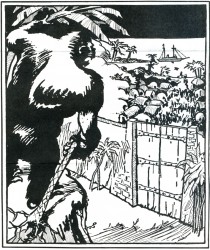 with the makers of the new King Kong film. Illustrated with exclusive behind-the-scenes photographs from the movie!
with the makers of the new King Kong film. Illustrated with exclusive behind-the-scenes photographs from the movie!
THE KING KONG CRITICS ROUNDTABLE – Several top animation fans’ opinions of the Paramount Pictures remake.
KING KONG IN PRINT and KING KONG ON ACETATE -Our regular review section, spotlighting this issue, books and records of recent vintage pertaining to the amazing anthropoid.
Features on Ray Harryhausen’s latest Dynarama effort SINBAD AND THE EYE OF THE TIGER, and the puppet filma of Rankin/Bass Productions.
CLOSEUP THREE: *Professionally printed and designed. *More pages, photos, and features than ever before. *A perfect addition to any special effects fan’s collection. *Printed on sturdy 80 Ib. gloss-coated paper in a strictly limited edition.
ALSO AVAILABLE: The Editors of CLOSEUP have obtained a limited amount of copies of a reprint booklet of a “new” King Kong novelization. This slim pamphlet, a reproduction of the English Boy’s Magazine for October 28th, 1933 has 8 fine illustrations, “How They Made King Kong,” and a full page advertisement for a Kong sequel “The Menace of the Monsters” (in which the prehistoric denizens of Skull Island are transported to England where they break loose and wreak havoc on an unsuspecting populace). Imported from England. Supply is extremely limited.
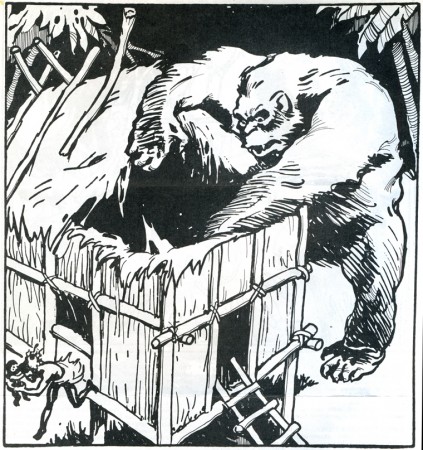
.
DAVID PRESTONE
46 -16 MARATHON PARKWAY
LITTLE NECK, NEW YORK 11362
(Checks and money orders must be made out to: DAVID PRESTONE.)
All orders have to be done through the mail.
These are all the original issues of the magazine – not reprints.
issue #1 – $50 postpaid
issue #2 – $25 postpaid
issue #3 – $25 postpaid
Bill Peckmann &Comic Art &Illustration 08 May 2010 09:16 am
Russell Brockbank
- I’m not familiar with the work of Russell Brockbank, a British cartoonist, but Bill Peckmann sent me this note, along with six pages of his cartoons. I thought I’d share:
Here are 6 pages of “Punch” cartoonist Russell Brockbank. Fortunately he also showed up in our “Road & Track” magazine from which these pages are taken.
 1
1(Clicka any page to enlarge.)
Bill Peckmann &Illustration 07 May 2010 08:50 am
The Cow and the Silver Cream
- I’ve posted a number of items by and about artist Vernon Grant and I’m glad to be able to showcase this rarity as well.
The Cow and the Silver Cream is a booklet that Vernon Grant wrote and illustrated in 1943 for the Wright Silver Cream Company. It was used as a giveaway item for those who sent in for it.
This item comes from the collection of Bill Peckmann and it’s an enormous rarity. I’m thrilled to be able to share it with you.
 1
1
Many thanks, once again, to the inimitable Bill Peckmann for this booklet. It’s a gem and it’s a real rarity.
For other posts about Vernon Grant, go here.
Animation &Articles on Animation &Commentary 06 May 2010 07:21 am
Dragons & Fanny
 - For the past few weeks, Michael Barrier’s review of How to Train Your Dragon has been on my mind. Actually, not most of the review, just the last two paragraphs. Most of the review talks about the Dreamworks film, and, I must say, it doesn’t encourage me to see it (which I eventually will most certainly do – once they screen it in 2D in New York).
- For the past few weeks, Michael Barrier’s review of How to Train Your Dragon has been on my mind. Actually, not most of the review, just the last two paragraphs. Most of the review talks about the Dreamworks film, and, I must say, it doesn’t encourage me to see it (which I eventually will most certainly do – once they screen it in 2D in New York).
I haven’t yet seen it , but the film, from the ads I’ve seen, looks like the generic Dreamworks product. All of the characters are supposed to be Vikings living in the First Century, but they act and sound like generic animated characters in the 21st Century. It’s just about a given for such current product. The stock facial expressions, the overarching eyebrows, the attitude. In all of the ads and clips I’ve seen, America Ferrara screams every one of her lines. That’s what poses for acting today in most animated films – a direct influence of TV.
Perhaps I’m wrong, but I somehow doubt it. I’ll find out for myself when I do see it. (After all I put down Kung Fu Panda, and I now think pretty highly of that film.) Regardless, this isn’t the part of the commentary that Mike’s written that has my thoughts rambling about.
 He jumps in his review to Marcel Pagnol’s Fanny Trilogy. Seeing these three films is perhaps one of my all time favorite movie experiences. They played in NY in the 70’s on three consecutive Mondays. I got so hooked into it, I looked forward enormously to those Monday showings. Mike describes them beautifully. All character development and a simple straightforward story that just about breaks your heart. It’s a wonderful film experience despite the fact that it’s a crusty old 1930’s film with lots of soft grays and soft focus. They’re obviously sets built around the Marseilles they’re pretending to create, but you buy it all. At least I did; it’s so wonderfully Romantic.
He jumps in his review to Marcel Pagnol’s Fanny Trilogy. Seeing these three films is perhaps one of my all time favorite movie experiences. They played in NY in the 70’s on three consecutive Mondays. I got so hooked into it, I looked forward enormously to those Monday showings. Mike describes them beautifully. All character development and a simple straightforward story that just about breaks your heart. It’s a wonderful film experience despite the fact that it’s a crusty old 1930’s film with lots of soft grays and soft focus. They’re obviously sets built around the Marseilles they’re pretending to create, but you buy it all. At least I did; it’s so wonderfully Romantic.
(Perhaps, that’s a generational thing. I talked an intern in my studio into watching Citizen Kane, and she couldn’t get through it. The B&W was too distracting for her, and she found the film boring. What can you say?)
Mike Barrier rightfully makes the leap to Snow White and the Seven Dwarfs, a natural link – animation wise – to Pagnol’s trilogy. The approach is very similar. Somehow I’d never have seen the link to these films, but it works. Despite the enormous difference in story, the dependence on character development and motivation are alike. A sweet, simple, direct story with very strong character personality holds you tightly throughout.
A lot of this approach stayed with the Disney features right through Sleeping Beauty. I love the first 10 or 15 minutes of all those films; nothing but character setup, and they’re all wonderful. Things started to change with 101 Dalmatians and had been just about abandoned by the time they got to The Aristocats. Character suddenly became reliant on celebrity voices. Thanks to the star turns such as Phil Harris’ Baloo the Bear in Jungle Book, it became easier for animators to pull their characters together. Let the voices do the heavywork, and in The Aristocrats, they ran with it to the film’s detriment.
Now we get unidentifiable celebrities, like America Ferrara, shouting their lines but adding nothing to the character’s personality. I’m not even sure if her name will help sell a DVD. Given these flat voices, the animators turn to their stock poses and facial expressions, and the end result is a sad lot.
I’d like to think that Chris Sanders and Dean DeBlois have surpassed the Dreamworks formula and taken their film to another level. I have been a big fan of Lilo and Stitch, although I think much of the story is hackneyed nonsense. (Whenever we have to see aliens fighting from their spaceship, it’s hard to reconcile that with the wonderful character traits between Lilo and Stitch, themselves.) The beautiful artwork choices help carry you through that film. Mike suggests that the end of Dragon may have as big a problem, and he offers to blame that on the executives above Sanders and DeBlois. Perhaps, but Lilo and Stitch had similar problems.
Mike Barrier suggests that that isn’t the entire case with How to Train Your Dragon, and I do hope he’s right. But nothing I’ve seen to date lets me expect it. I do want to be pleasantly surprised, and I’ll let you know if I am.
The film I’m really waiting to see is Sylvan Chomet’s The Illusionist. The story in Triplettes of Belleville fell apart, but the execution and development of the principal personalities was so fine, that the film offered me plenty – and plenty of hope. I do hope and almost expect to see that he has taken this approach to another level. What little I’ve seen leads me to believe I may not be disappointed.
Independent Animation 05 May 2010 08:49 am
Servais bio
- Last week, I posted a piece from Animafilm #1 by Raoul Servais. Of course, I’m sure that many of those reading this today do not know who Mr. Servais was. Consequently, I’ve decided to follow that post with this bio of the Master animator of the 70′s.
If you’re at all interested, here’s a bio from that same Animafilm issue.
Raoul Servais was born in Qstend on 1st May 1928. In 1950 he graduated from the applied arts department of the Royal Academy of Fine Arts in Ghent.
 Already in 1946, with the aid of his professor and a few friends, he produced a short cartoon entitled “Een spookhistorie” (Une histoire de fantome, A History of a Ghost). This film has been shot with a camera made of a cigarbox and parts of a “Small Mechanic” toy kit for kids… Having made some experimental films on a 8 mm reel, he decided to thoroughly study the applications of an animated cartoon. Step by step, owing to his perseverance and obstinacy, he became a master. Servais is an example of a self-tought man with iron-firm determination. Armed with the technical learning, he set about making animated films. His brilliant career in this field, however, should not make us forget the fact, that he had been a very active painter and graphic artist — winning awards at many painting and graphic art competitions – and had also participated with Rene Magritte in the making of the monumental “Domaine Enchante” (Spell-bound Manor). Film has nevertheless remained his main objective. In 1960, as mentioned in his filmography, he completed his first animated cartoon – “Havenlichten” (Lumieres du port, Lights of the Harbour). From then on his films never fail to appear regularly, winning numerous awards and important distinctions all the world over. His awarded films are enumerated in the alphabetical order in the appendix. Member of the Academic Royale des Sciences, Lettres et Beaux-Arts de Belgjque (Belgian Royal Academy of Sciences, Literature and Fine Arts), Raoul Servais has been a professor of Academic Royale des Beaux-Arts (Royal Academy of Fine Arts) in Ghent since 1960. There, with a lot of verve, he has been supervising the animated cartoon department. Mention must also be made of the fact, that for a couple of years now he has been a lecturer in Ecole Nationale Superieure d’Architecture et des Arts Visuels (National Higher School of Architecture and Visual Arts) in Brussels (La Cambre).
Already in 1946, with the aid of his professor and a few friends, he produced a short cartoon entitled “Een spookhistorie” (Une histoire de fantome, A History of a Ghost). This film has been shot with a camera made of a cigarbox and parts of a “Small Mechanic” toy kit for kids… Having made some experimental films on a 8 mm reel, he decided to thoroughly study the applications of an animated cartoon. Step by step, owing to his perseverance and obstinacy, he became a master. Servais is an example of a self-tought man with iron-firm determination. Armed with the technical learning, he set about making animated films. His brilliant career in this field, however, should not make us forget the fact, that he had been a very active painter and graphic artist — winning awards at many painting and graphic art competitions – and had also participated with Rene Magritte in the making of the monumental “Domaine Enchante” (Spell-bound Manor). Film has nevertheless remained his main objective. In 1960, as mentioned in his filmography, he completed his first animated cartoon – “Havenlichten” (Lumieres du port, Lights of the Harbour). From then on his films never fail to appear regularly, winning numerous awards and important distinctions all the world over. His awarded films are enumerated in the alphabetical order in the appendix. Member of the Academic Royale des Sciences, Lettres et Beaux-Arts de Belgjque (Belgian Royal Academy of Sciences, Literature and Fine Arts), Raoul Servais has been a professor of Academic Royale des Beaux-Arts (Royal Academy of Fine Arts) in Ghent since 1960. There, with a lot of verve, he has been supervising the animated cartoon department. Mention must also be made of the fact, that for a couple of years now he has been a lecturer in Ecole Nationale Superieure d’Architecture et des Arts Visuels (National Higher School of Architecture and Visual Arts) in Brussels (La Cambre).
Raoul Servais’ career means putting himself constantly to test, perpetually overcoming his own self – as far as both his creative works and his techniques are concerned. It is worth stressing, that each of his films renovates graphic expression’. Full of contempt for repetitions, Servais in his films confronts the spectator with the multiple aspects of his artistic activity.
If we realize such obvious facts like the abuse of all film genres, unevenness-whatever this might imply – warranting his dedication, Raoul Servais is then a totally committed artist, deeply concerned with honesty with which we should face life and the rules life imposes. In this state of mind commitment is inevitable. Servais – a contestator certainly not without reason, is no opportunist. He is human in the broadest sense.
Brutal accents are rarely found in his films. It is refinement and poetry that make his message universal. Raoul Servais was a member of the jury of the international festivals in Cracow, Oberhausen, Teheran and New York.
N. Vander Vorst.
Image from his last film, “Harpy”
RAOUL SERVAIS FILMOGRAPHY
1959 – “HA VENLICHTEN” (Lumieres du port, Lights of the Harbour), 1st prize for an animated cartoon at the National Belgian Film Festival, Antwerp,
1960.1964~”DE VALSE NOOT” (La fausse note, False Note). Grand Prix for an animated cartoon.at the National Belgian Film Festival, Antwerp, 1964; 1st prize for an animated cartoon at the Benelux Festival, Mortsel, 1965.
1966 “CHROMOPHOBIA ” (Chromophobia). St Marc’s Lion -Grand Prix for an animated cartoon at the International Festival of Short and Documentary Films, Venice, 1966; Silver Miqueldi at the International Festival of Short Films, Bilbao, 1967; 1st prize for an animated cartoon at the International Youth Films Festival, Hyeres, 1969; 1st prize for an animated cartoon, film critics’ award, Minister of Culture award at the International Festival of Films for Children and Youth, Teheran, 1967; special prizes of the jury at Moscow and Leipzig Festivals, 1967; Grand Prix for an animated cartoon at the National Belgian Film Festival, Antwerp, 1966; 1st prize for an animated cartoon at the Benelux Festival, s’Hertogenbosch, 1966; CIDALCprize; label and prize for the quality, France, 1966; Pradikat, GFR, 1966; 1st prize for an animated cartoon at the International Film Festival, Ramat’gan,
1971. – “SIRENE” (Sirene). Golden Statuette – Grand Prix for an animated cartoon at the International Festival of Films for Children and Youth, Teheran, 1968, film critics’award at the same festival; Silver Hugo – the International Film Festival award, Chicago, 1969; Silver Pelican – the International Animated Cartoons Festival award, Mama/a, 1968; Silver Boomerang-International Film Festival award, Melbourne, 1969; 1st prize for an animated cartoon at the International Film Festival, Philadelphia, 1970; Grand Prix for an animated cartoon at the National Belgian Film Festival, Antwerp, 1968; Prize for the best colour film, 1968; Label – for quality, Italy; 1969 – “GOLDFRAME”, Grand Prix for an animated cartoon at the National Belgian Film Festival, Antwerp, 1968; TV/BRTaward at the same festival; distinction at the International Film Festival, Sydney, 1969; selected for the International Film Festival, Cannes, 1969; put up for Academy Award, Chicago, 1970; Label – for quality, France.
1970-”TOSPEAK OR NOT TO SPEAK”, Grand Prix of the public at the International Festival of Short Films, Oberhausen, 1971; ASIFA award and prizes of GFR Film Clubs at the same festival; special mention at the International Animated Cartoons Festival, Annecy, 1971; Grand Prix for an animated cartoon at the National Belgian Film Festival, Knokke-Le-Zoute, 1971.
1972 – “OPERATION X-70″, Special award of the jury at the International Film Festival, Cannes, 1972; 1st prize at the International Animated Cartoons Festival, Zagreb, 1972; Grand Prix for an animated cartoon at the National Belgian Film Festival, Knokke-le-Zoute, 1971.
1973 – “PEGASUS”, Grand Prix of the public at the International Film Festival, Antwerp, 1973; selected for the International Film Festival in Berlin.
1976 – “LE CHANT DE HALEWYN”(Halewyn’s Chant) – one part of a TV series: ,,Legends of Europe”).
1978 -”HARPY” (Harpy), Special prize of the jury at the International Film Festival, Odensee, 1978, with regard to Raoul Servais total film output.
Following Masereel and L. P. Boon, the VAN ACKER reward was granted to Raoul Servais in 1976.
Articles on Animation &Bill Peckmann &Comic Art &Disney 04 May 2010 07:42 am
Barks in Panels
- Last week I posted Alex Toth‘s Jesse Marsh piece from the magazine Panels. Bill Peckmann who was the Associate Editor of the mag, answered my request and sent the article I noticed about Carl Barks. In fact, he sent me additional Barks material he’s saved.
These include a the following letter Carl Barks had sent him as well as a couple of images.
 1
1(Click any image to enlarge.)
Here’s the article from Panels, an interview between Ed Summers and Carl Barks.
 1
1
As ever, many thanks to Bill Peckmann.
Animation &Animation Artifacts &Disney 03 May 2010 08:01 am
All the Cats – pt 3
- This scene is a continuation of animation from All the Cats Join In. It’s another scene by Fred Moore and is, to me, one of the highlights of the film. The girl keeps jitterbugging even though shes rapt in conversation on the phone.
The problem I had was twofold. The xerox copies offered no registration and there were no visible numbers on most of the drawings. Hence, I did the best I could to register them, even though I couldn’t use the ever-moving feet as an achor.
 1
1
I’ll post the remainder of this scene next week.
The following QT movie represents all the drawings in the scene.
Since I had no numbers to go by, I exposed all drawings on twos.
Right side to watch single frame.
Many thanks for the loan of this scene by Lou Scarborough.
Photos 02 May 2010 09:54 am
Emily Dickinson @ Botanical Gardens
- The invitation read:

Poem In Your Pocket Day
A Citywide celebration of poetry and literacy where
New Yorkers are encouraged to carry a poem in their pocket
and share it with their friends, family, co-workers and classmates.
and
Grand Opening Preview of
Emily Dickenson’s Garden: The Poetry of Flowers
The Botanical Garden’s Spring Exhibition illuminating
Dickinson’s life, gardens and poems.
My friend, Steven Fisher was there to capture the event on film.

Within the exhibit, there is a model of Emily Dickinson’s home.

Of course, the primary exhibit in the Botanical Garden is the flowers.

There were plenty of treats to be had.

Finally, the celebrity guests arrived to make the presentation.
Sigourney Weaver.
Many thanks, Steve for the great photos.



















